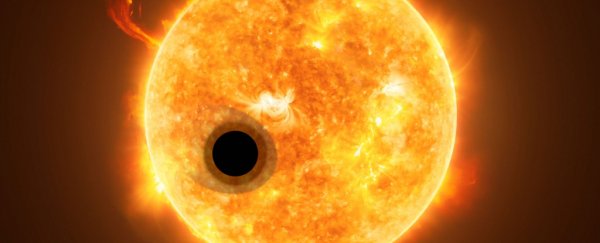Well over 4,000 exoplanets orbiting other stars in the Milky Way have been identified and confirmed to date. From that population, a curious pattern has emerged: there are extremely few exoplanets between 1.5 and 2 times the size of Earth orbiting close to their stars, a phenomenon known as the small planet radius gap.
Where did they all go? Did they even exist to start with? It's a bizarre mystery, but new research may have just brought us closer to an answer. According to observations, simulations, and modeling, it's likely those exoplanets did exist, and shrunk over billions of years.
"The overarching point is that planets are not the static spheres of rocks and gas we sometimes tend to think of them as," said astrophysicist Trevor David of the Flatiron Institute in New York City.
The small planet radius gap, first identified in 2017, is interesting because it falls between two classifications of exoplanets - Earth-sized worlds, and mini-Neptunes that are smaller than Neptune, but still have very thick Neptune-like atmospheres.
There are several possible scenarios that scientists have proposed to explain this strange anomaly. One is that they may have just formed that way, from clouds of material that are too sparse to build a Neptune-like atmosphere - but the leading theory is that the exoplanets initially formed larger, before later shrinking due to atmospheric loss.
This idea has been investigated before, but David and his team added a new parameter to their analysis: the ages of the exoplanets, which form at the same time as their stars.
They selected a bunch of exoplanets less than 10 times the size of Earth from the California-Kepler Survey, a project to measure the precise properties of exoplanets and their host stars.
This data allowed them to accurately obtain a population of the correct size range. Then, they calculated the ages of the stars using their chemical composition and light fluctuations - two properties that are linked to how old a star is.
From there, the next step was to divide the systems into two populations - those younger than about 2 billion years, and those older. (The Solar System, for context, is about 4.6 billion years old.) Once they had done so, the researchers noticed an interesting pattern.
The mass gap isn't completely empty, you see, and the distribution of exoplanets in that gap seemed to be divided by age. For the younger systems, the gap was emptiest in the 1.6-Earth radii region. For the older systems, it was emptiest around 1.8 Earth radii.
The research team interpreted this to mean that some mini-Neptunes shrink quite dramatically over billions of years, losing their atmospheres to eventually leave just a naked core behind - something we may have actually observed in exoplanets.
Above a certain critical limit, the mini-Neptunes have enough mass to gravitationally hold onto their atmospheres, resulting in the observed gap.
As for what's causing the atmospheric loss, that is still unknown.
One proposed scenario is asteroid or meteor bombardment. Given that the observed process takes billions of years, that's unlikely, the researchers concluded; bombardment would strip an atmosphere over much shorter timescales, less than 100 million years.
That leaves two main options. The first is photoevaporation, where the close proximity between the star and planet is enough for the star's radiation to strip the atmosphere. The second is core cooling, where heat escaping from the planetary core enters the atmosphere and helps strip it away from within.
These two different processes occur on different timescales, both of which fit the team's observations. This means that more analysis is required to determine what, exactly, is shrinking exoplanets.
"Probably both effects are important," David said, "but we'll need more sophisticated models to tell how much each of them contributes and when."
The research has been published in The Astronomical Journal.
